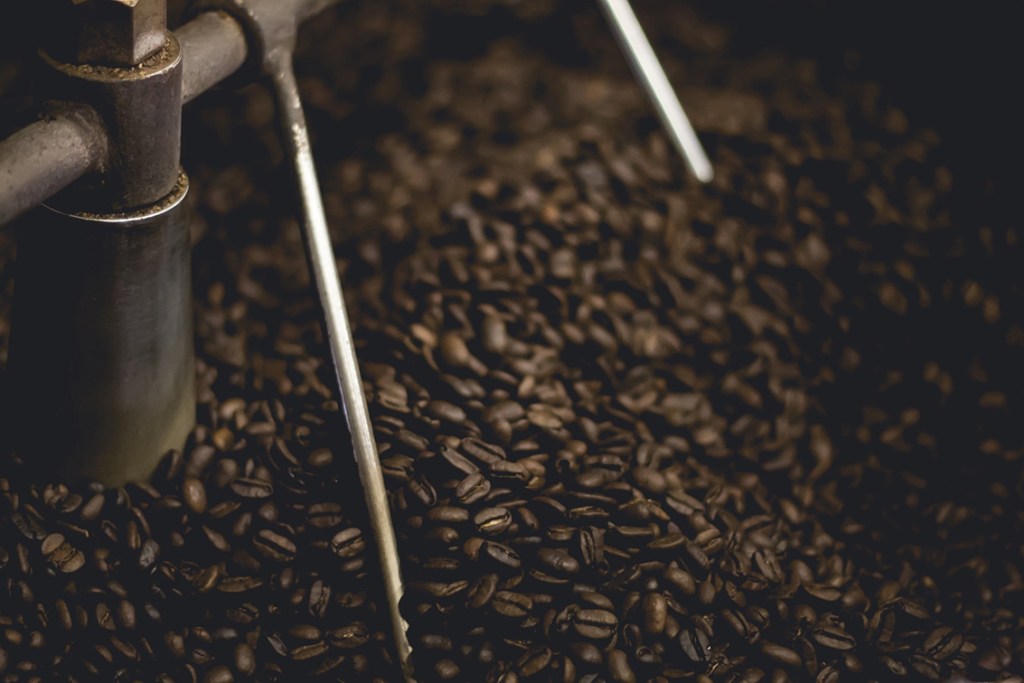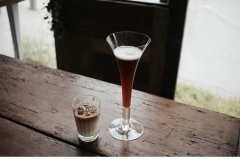Where does the sour, bitter, sweet and sweet in coffee come from? Why is coffee sour and bitter?

Professional coffee knowledge exchange More coffee bean information Please pay attention to coffee workshop (Weixin Official Accounts cafe_style)
The source of coffee sourness is the difference between pleasant and unpleasant acids.
Why do some coffees taste sour? Some even smell like fruit vinegar.
Why do some beans look shiny? Is it because it's been stored for a long time?
Why is coffee bitter?
And--and caffeine. . . . Is it true that the longer the coffee is roasted, the less caffeine there is?
To understand these questions, you must first understand the composition of coffee and coffee roasting!
Our usual brown coffee beans, with a little aroma, are ripe beans of coffee that have been roasted.
Unroasted coffee is called green beans or green beans. In addition to water, the other components of raw beans are carbohydrates (also known as carbohydrates), proteins, lipids, organic acids, minerals, trigonelline, and other acidic substances (mainly chlorogenic acid).
What does raw beans taste like? If someone asked, probably can only answer: "raw bean taste, is the taste of raw beans, wait until you taste, oh oh right right this is the taste of raw beans."
The taste of green beans is so different from that of cooked beans that someone once said,"80% of the taste of coffee is determined by green beans, and the other 20% depends on roasting."
For a successful coffee shop, the people behind the scenes who buy and roast coffee beans must have sophisticated skills and keen tastes. Unlike wine tasting, where a group of people make the final decision, coffee is operated by one person, a true "roaster" who, apart from not being involved in planting, harvesting, and processing, does everything himself: buys beans, decides on the mix of blends, and uses his sixth sense to judge the time and temperature of roasting.
A clumsy, distracted roaster can turn a company's investment into smoke, while a competent roaster can turn second-rate coffee beans into a well-flavored blend, and high-quality beans are even more memorable.
Coffee Chemical Factory
Hot baked bread, crispy French fries, even the aroma of grilled onions, etc., are all caused by chemical changes in heat that produce so-called volatile compounds. Roasted coffee beans are also the same reason, in the process of high temperature heating, start the "caramelization reaction" and "Mena reaction", showing a unique good taste.
sugars
Sucrose, which accounts for about half of the dry matter, is thought to be associated with coffee flavor, and the higher the sucrose content, the better the coffee tastes, as evidenced by the far superior flavor of Arabica to Robusta (Arabica has about twice as much sucrose as Robusta). Sugar content of coffee is mainly stored in the form of sucrose, and sucrose concentration is highest after coffee fruit ripens. The study found that defective coffee beans, or undercooked beans, also had low sucrose content.
When beans are in hot water, sucrose in the body is involved in the caramelization reaction. Sucrose dehydration, release of moisture and carbon dioxide, release of hundreds of aromatic substances, including creamy sugar flavor (diacetyl, Diacatyl), caramel flavor. Caramel accounts for about 17% of the weight of coffee beans, bitter taste with sweet, coffee is an important taste.
Not only that, sucrose also contributes to enhancing the sour flavor of coffee. Acetic acid, lactic acid, glycolic acid, and formic acid, which belong to the fatty acid family, are all aromatic acids created by sucrose in baking. These acids reach maximum concentrations in light to medium roasts.
Sucrose relatives, such as glucose, fructose, lactose, maltose and other reducing sugars, encounter amino acids, produce another type of chemical reaction, called "Mena reaction", will undergo a complex series of degradation and polymerization, emitting aroma. Hundreds of aromatic compounds were created, including glycosamine, furfurural, and melanin (the pigment in coffee beans).
pistachio -1 Sometimes roasted coffee beans with a strong nutty aroma photo by Krzysztof Puszczyński
organic acid
Chlorogenic acid is the main organic acid in mung bean seeds. During heating, part of chlorogenic acid will be converted into bitter chlorogenic acid lactone.
Another portion of chlorogenic acid degrades to quinic acid and caffeic acid.
Quinic acid is thought to be a source of bitterness in dark roasted beans, but the American Fine Arts Association believes that quinic acid is water-soluble and, in addition to increasing the body, also increases the complexity and brightness of coffee. Coffee acid is slightly astringent.
In addition to chlorogenic acid, green coffee beans also contain citric acid and malic acid, but these two acids are considered "sharp acids" and decrease with the roasting process.
* Chlorogenic acid, quinic acid, caffeic acid, are antioxidants, so coffee cooked fresh drink, only have antioxidant function.
trigonelline
Trigonelline has a bitter taste, and during baking trigonelline is degraded into many aromatic substances, including niacin (commonly known as vitamin B3) and other aroma molecules with caramel and mushroom flavors. The more trigonelline is degraded by roasting, the better the coffee taste, the more nicotinic acid is produced.
lipid
The amount of fat will affect the taste of coffee, and many substances that add coffee flavor are fat-soluble, that is, dissolved in fat. Coffee has a lot of fat, so it tastes extra round. In contrast to other substances, roasted beans have less carbohydrates and protein, but more lipids. Arabica tastes better than Robusta, thanks to fat.
lemon good medium roast coffee can sometimes taste the sour and sweet taste characteristic of fruit photo by Patryk Dziejma
Medium VS Deep
Suppose we are all green beans, in the hard green body, water only accounts for 12 percent of the small body.
Green beans are thrown into a hot oven one by one, and for the sake of equal heat, they are not only roasted by the fire, but also endure constant flipping. When the body's water temperature reaches 100 degrees Celsius, it will evaporate, while carbohydrates are also decomposed by heat, producing carbon dioxide, these powerful airflow in the body flow, the more tired, finally nowhere to go, had to carry a "explosion" out of the body. At this time, you will hear the sound like popcorn, pop! Explode! Explode! It was very lively, and the fragrance immediately overflowed. This process was called "explosion". It was no longer green beans, but brown beans.
Since there is one explosion, it means that there will be two explosions next. Before the second explosion has not yet arrived, we define the baking degree at this time as medium baking. Medium-roasted beans can highlight the "regional flavor" of coffee producing areas, reduce the processing of roasted flavor, and drink the delicate aromatic acid of beans themselves. The concentration of aromatic acid produced by sucrose combination reaches its maximum in light to medium baking.
When the beans continue to be heated, into the second explosion, the second explosion began 20-40 seconds, began to smell the smell of coke, the surface of the bean body was dotted with oil. It's medium-deep roast.
When the explosion of the second explosion reaches the maximum density, the oil shine is more obvious, and it is deep baking.
At this time, the blessing of sucrose produced acetic acid, lactic acid, glycolic acid and formic acid, into the deep baking after rapid decay. (reduced acidity)
Not only that, chlorogenic acid is first degraded to bitter chlorogenic acid lactone, if you continue to heat the beans, chlorogenic acid lactone will be degraded to more bitter phenyl lindane (Phenylindane), which is why the heavier the baking, the more bitter. (bitter increased)
And that's not all. Deep roast coffee has only 30% citric acid and malic acid left. (acidity continues to decrease)
However, deep roasting also has its advantages.
Trigonelline fraction. Trigonelline has a bitter taste. The more trigonelline was degraded, the more nicotinic acid was obtained with the increase of baking time. The study found that dark-roasted beans contained 4-5 mg of nicotinic acid per 10 grams, and medium-roasted coffee beans contained less, only 0.8-1.5 mg of nicotinic acid per 10 grams. (Nicotinic acid more)
summary
Medium Roast: Bright acidity, sweet, light bitterness, distinct texture, provided beans are used well.
Deep Roast: Low and thick, no significant sourness, but sweet throat, good beans are still a prerequisite.
Bean oil situation: light baking, medium baking will not appear oily luster, medium and deep baking began to point out oil, deep baking oily obvious.
Many people often criticize dark baked beans for being so shiny that they are designed to carbonize to hide the bad taste of rotten beans.(such as the stinky grain fermentation taste of thick beans, metal or turbid earthy taste), it makes sense, because most manufacturers do not spend a lot of money to use good beans, accustomed to deep roasting to remove the bad taste of rotten beans, so often only drink a bitter taste of burnt throat, or add a lot of water to dilute, a convenience store sells American coffee, drink the feeling, just a sentence "light as water".
Caffeine issues
The ambient temperature required for the first explosion of coffee beans is about 170-205 degrees Celsius, and the temperature required for the second explosion is about 203-220 degrees Celsius. The melting point of caffeine is 237 degrees Celsius, so as long as the roasting temperature is below 237 degrees Celsius, caffeine will not be reduced, so the same batch of beans, medium roast or deep roast coffee contains the same amount of caffeine.
Some people might say,"I drink dark roast coffee more easily."
The reason for this is that deep-roasted beans take longer to bake, lose more moisture, and are lighter, so when weighing 10 grams of beans, deep-roasted beans require more beans, and of course have higher caffeine content.
resources
1. Coffee Science by Han Huaizong Published by Shizhou Cultural Enterprise Co., Ltd.
2. The Joy of Coffee by Corby Kummer Liu Shouhuai Translation Times Culture Publishing Enterprise Co., Ltd.
3. The Pharmacology of a Cup of Coffee, King of All Medicines, by Kitaro Oka Translated by Li Yuzhao Morning Star Publishing Limited
。
Important Notice :
前街咖啡 FrontStreet Coffee has moved to new addredd:
FrontStreet Coffee Address: 315,Donghua East Road,GuangZhou
Tel:020 38364473
- Prev

A correct understanding of the sour roasting degree and PH value of coffee determines whether the coffee acid is good or bitter.
Professional coffee knowledge exchange more coffee bean information Please follow the coffee workshop (Wechat official account cafe_style) Coffee sour source pleasant sour and unpleasant sour understanding of coffee sour lady, why today's breakfast coffee drink sour, I do not like, can you give me a cup of unsour coffee? This problem has always plagued coffee industry. Most people mistakenly think
- Next

Does coffee have the effect of losing weight? Drinking coffee after breakfast can help you lose weight?
Professional coffee knowledge exchange more coffee bean information please follow the coffee workshop (Wechat official account cafe_style) bulletproof coffee diet! Can bulletproof coffee really lose weight? can you lose weight by drinking one cup in the morning? do you like coffee? Taiwanese drink an average of 120 cups of freshly brewed coffee a year, double that of 10 years ago. Have a cup of coffee! It's a stylish and cozy pronoun, but palpitations and stomachaches
Related
- Beginners will see the "Coffee pull flower" guide!
- What is the difference between ice blog purified milk and ordinary milk coffee?
- Why is the Philippines the largest producer of crops in Liberia?
- For coffee extraction, should the fine powder be retained?
- How does extracted espresso fill pressed powder? How much strength does it take to press the powder?
- How to make jasmine cold extract coffee? Is the jasmine + latte good?
- Will this little toy really make the coffee taste better? How does Lily Drip affect coffee extraction?
- Will the action of slapping the filter cup also affect coffee extraction?
- What's the difference between powder-to-water ratio and powder-to-liquid ratio?
- What is the Ethiopian local species? What does it have to do with Heirloom native species?

